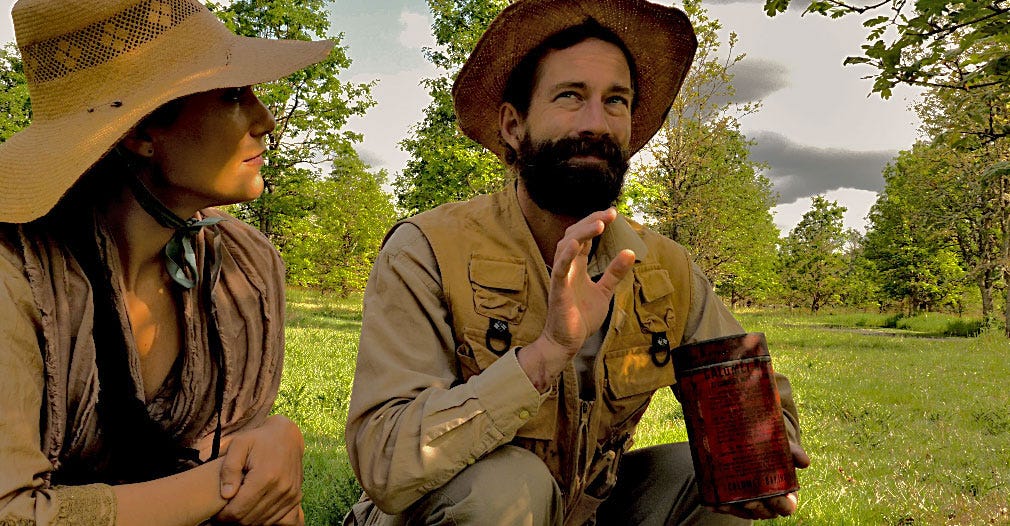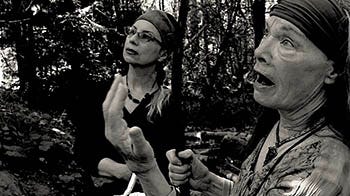In Antero Alli’s moving, beautifully wrought feature film The Alchemy of Sulphur, real and imaginary worlds frequently overlap. The film’s prolog succinctly lays out the themes: a folksy looking man in a beard and sandals introduces himself as “a character in a story being written by a woman named Hope.” But he claims that Hope is also a character in a story which he is writing, an allusion, perhaps, the the oft-noted phenomenon that writers feel that the characters in their stories are telling them what to write. “As with any literary character,” he continues, “we are figments of the author’s imagination.” Alli sets up a scenario which explores the relationship between external reality and the imagination. The film questions our notions of which of them is, in fact, more “real.” Like films since The Wizard of Oz and Stalker, Alli uses black and white to denote one level of reality (Hope’s external environment), and color to denote another (her fictional story). What’s less clear, from the outset, is how the levels affect one another. That both the color and the black and white photography are stunningly beautiful only helps to make these distinctions more effective.
Hope (Helia Rasti) is passionately attached to her work as a professional fiction writer. Her boyfriend Ben (Benjamin Ervin) seems to love her in a sincere and open-hearted way, but he’s an immature brat. He doesn’t know how to conduct a relationship with an artist, how to support and nurture her work. She’s so obsessive about her work, however, that she treats him carelessly as well. She sees emotional involvements as a direct threat to her work, and constantly pushes him away, so she can run back to her computer. Neither of them are winning awards for their relationship skills.
In her story, the folksy man is Phineas (perfectly embodied by Douglas Allen), a dendrologist in residence at a gorgeous coastal nature reserve, studying the devastation of coastal oaks, which are succumbing en masse to Sudden Oak Death. He wanders among the dying trees, taking notes in pencil in a worn notebook. He develops a flirtatious relationship with Helen, an amateur birder and divorcée, who is, she says, at the nature preserve “to meet her third husband.” (Also played by Rasti; who is excellent in her dual roles of Hope and her fictional alter ego, Helen.)
Sylvi Alli and Cynthia Schwell play two wise women, first seen walking through the woods near Hope’s apartment. In one way, they are stereotypical “crone” figures, and depending on the viewer’s taste and tolerance for the occult, some might view them as engaging in ridiculous mumbo jumbo with their shamanic chants and auras, but Alli and Schwell play their roles with warmth and conviction, and they ably carry out their function in the story, which is to discover and unleash Hope’s hidden powers of intuition and inner sight. They diagnose her as one who is blocking her own power, short-circuiting herself. (Sylvi Alli is also the composer of film’s effective score.)
The “sulphur” of the title plays off of the alchemical role of sulphur as sexual energy, and its usefulness in treating sick oak trees. The trees are dying, Hope funnels her sexual energy towards the creation of imaginary worlds, and in the alchemical transformation of one type of energy into another, the elements of the two stories seem to be metaphors for one another. Yes, the sick trees seem to be images of Hope’s blocked potential, but it is just as useful to say that her psychic crisis is being fed by the ecological imbalance unfolding along the Oregon coast.
In a sense, these dying trees are the protagonists of the film, if only because the crisis of an entire ecosystem is so much larger than anyone’s personal crisis. Poignantly, the lacy fungus makes them look stunningly beautiful, even while dying. One can feel the death of the trees weighing down Phineas and Helen, and weighing on Hope, their author. Ecological disasters have a deep and devastating effect on all of us, sometimes in invisible ways, even if we don’t personally become climate refugees, fleeing for our lives from the flames.
Phineas explains that the plight of the oaks is man-made: it’s caused by fire suppression, since the natural cycle of forest fires normally keeps the fungus in check. Sulphur, the fire element, brings temporary relief if applied to the roots, but forests need periodic fires, and artists need love and passion.
Phineas accuses Helen of being like the fungus. He describes her as “stalking the dark woods for stories.” Helen is Hope’s stand-in, and by identifying her with a destructive disease, he is branding her creative work as out of control, crowding out the needs of the heart. Like the fungus, Hope’s work is essential, but not when it overruns her psychic environment. (She may be trying to write a simple romance story, but her story is wiser than she is.)
The film’s plot ingenuously articulates Hope’s transformation and struggle, continuing to intertwine different layers of fiction, fantasy, inner vision, and daily life, with the two wise women acting as key catalysts for change. Although there are several moments of drama, overall, the pace is measured and contemplative, but expertly crafted so that, once you get pulled into its slower pace, every moment counts, and the pauses and silences are full of expressive nuance. The slow pace becomes essential, allowing the viewer to enter into Hope’s intuitive flashes, which is where the story really takes place. Alli effectively uses dance, music, and subtle visual effects to poetically develop the alchemical aspects of the story.
Alli’s films have always explored our relationship with invisible worlds, but in The Alchemy of Sulphur, we have the master’s voice at the top of his game, allowing the language, story, images and sounds to distill out of the ether and arrive in our consciousness in crystalline, perfect form, a true act of cinematic alchemy.
My articles on experimental film are freely available to all, but are supported by monthly and annual donations from readers. Please consider becoming a paid subscriber to support my work. Thank you.





